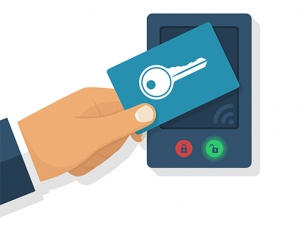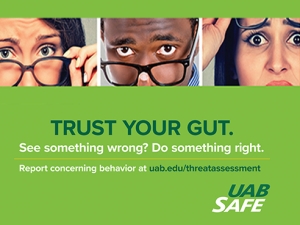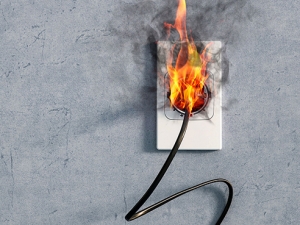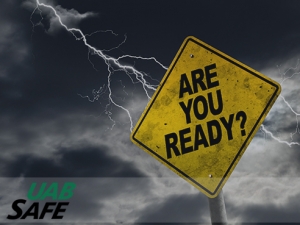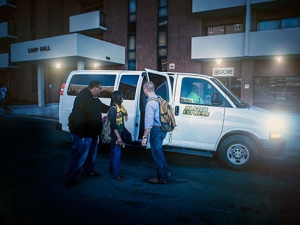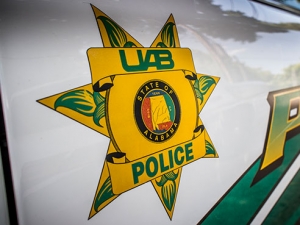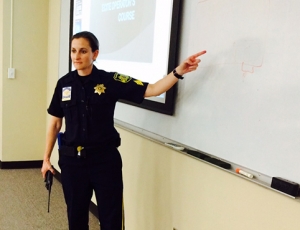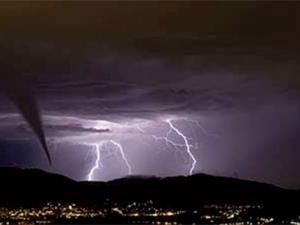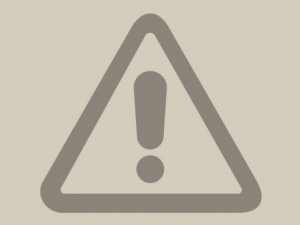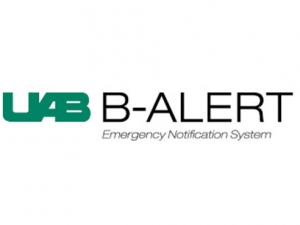Leah Boozer followed her normal pre-bedtime routine Sunday, Jan. 22 — a routine that includes taking her hearing aids out and placing them and her cell phone on the nightstand next to her bed.
 |
| Leah Boozer says the flashing light from her cell phone woke her up just shortly after 3:30 a.m. the morning of Jan. 23 when the B-ALERT system was activated, warning UAB’s campus and its employees that a tornado was close to the university. |
The flashing light of Boozer’s cell phone awakened her just after 3:30 a.m. Then the Center Point resident’s home telephone rang, and an e-mail quickly followed on her cell phone. A text message appeared a few seconds later, too.
The messages came via B-ALERT — a technologically advanced emergency notification system that came online Feb. 3, 2011 — and were delivered by UAB’s Emergency Management Team, alerting Boozer that a thunderstorm producing a possible tornado was close to the university.
“I listened to the cell-phone message first and then got the call on my home phone,” says Boozer, training coordinator for the Center for Community Outreach and Development’s Alabama Math, Science and Technology Initiative. “I ran upstairs and woke my son and his wife, and I got my husband out of the living room. We could see the tornado was coming our direction, and we grabbed our animals and all went downstairs in the basement. If it had hit my house, the B-ALERT message is what would have given us a chance to live.”
And it was a close call. Just two miles away from Boozer, the Paradise Valley neighborhood in Clay was heavily damaged when a pre-dawn, EF-3 tornado, estimated to be about 800 yards wide, hit the George Brook, Steeplechase, Pilgrim’s Rest and Rosewood subdivisions and had a damage path length of 15.5 miles. The January tornado outbreak in Alabama killed two people, injured hundreds of others and damaged or destroyed roughly 500 homes.
Boozer didn’t go to bed unprepared for the storms, either. She knew there was a severe weather threat and had her weather radio in the room with her. The weather radio, however, never worked during the storm, she said.
“I went to a weather workshop not long ago and got the alert radio there, but for whatever reason it never went off,” Boozer says. “I don’t know what happened. I carried it downstairs, and when I flipped it on a different setting, I didn’t get anything — no updates or alerts. It was as if it were dead, so I thought the batteries may be dead, although it had been used very little. When I got back upstairs after the storm passed and sat it on my dresser, all of a sudden it started giving the weather updates but still no alerts.”
At UAB, Emergency Preparedness, the UAB Police Department, Information Technology and the Office of Public Relations & Marketing teamed up to implement B-ALERT one year ago, upgrading from a system previously in use. All registration for the system is connected to your BlazerID. The registration form is online at www.uab.edu/BALERT. A link to the registration form is always at www.uab.edu/emergency.
Boozer was among a number of UAB employees and students who wrote follow-up emails to the Emergency Management Team crediting B-ALERT with notifying them of dangerous weather conditions.
“The UAB alert system phone call is what actually woke me up when the storm was coming, and I subsequently woke my family,” business student Cheryl Smith wrote. “I never heard the sirens.”
Smith spent the Monday morning and afternoon after the tornado hit helping neighbors evacuate their homes, supporting her community through organizing and distributing donations and just lending an ear to those affected.
UAB business alumnus Paul Smith says he’s not sure the tornado sirens would have awakened him or his wife. The phone ringing, he says, woke them up and gave them time to prepare.
“Thankfully, the tornado was a mile north of us, but because of this system, my family was able to prepare as best that we could have to get in our safe places,” Smith says.
UAB’s primary concern during any emergency or severe weather situation is the safety of its students, faculty, staff and visitors, and the switch to B-ALERT enabled the university to take advantage of advances in technology.
Bryan Breland, director of emergency management, says UAB will only activate the system when they have information that the school is under a tornado warning. This was an instance where the university warning helped those in nearby communities.
“We only send out emergency warnings when there is a direct threat to the UAB campus,” Breland says. “That reduces the number of false alarms and hopefully makes our staff and students take notice when the calls do go out.”
B-ALERT messages were sent to more than 40,000 faculty, students and campus and health-system employees. Though there has been much positive feedback for B-ALERT, Breland says some were unhappy to have their phones ring at 3:30 a.m.
“I’m okay with waking people up in order to keep them safe,” Breland says. “And there are employees and students on campus at all times of the day and night, including overnight shifts in the medical center. And many of our younger students, especially our undergraduate students, live on or very close to campus. We need people to understand that we’ll only call you if we need to, but when we do, take it seriously.”
Emergency events on campuses around the country have dramatically shaped the way universities notify employees and students in crisis situations. UAB Police Chief Anthony Purcell says this event shows that recent advances in technology such as those UAB has adopted can make a difference in times of emergency.
“Emergency response in a university environment has changed dramatically, especially in recent years,” Purcell says. “We are fortunate at UAB to have drawn on the resources of our peer, accredited police departments around the country to determine best practices for communicating during a situation that requires immediate action on the part of faculty, staff and students.
“Hearing the stories of people who were able to get themselves and their families to safety because of B-ALERT just underscores the importance of a team approach to emergency management,” Purcell says. “The work we did with other departments this past year to determine which system to purchase and implement and the ongoing training that we all participate in truly has made a difference in our ability to communicate quickly in multiple ways to those affected.”
Anyone with a BlazerID can register up to 10 phone numbers for B-ALERT by visiting www.uab.edu/BALERT. SMS-capable mobile devices also can be registered to receive text messages. All BlazerID-connected UAB email addresses automatically are included in the system. If there are other email accounts at which you would like to receive notifications, register those separately in the system. You can also follow B-ALERT on Facebook at www.facebook.com/UABALERT and on Twitter under the name UABALERT: www.twitter.com/UABALERT.
“It’s important that all of our employees and students have some method in place for getting crucial emergency information in a timely manner, either through local television and radio, B-ALERT or a weather radio,” Breland says. “But I do think it’s important that we don’t underestimate the importance of rare, middle-of-the-night calls. That’s probably when a system like this is most helpful.”


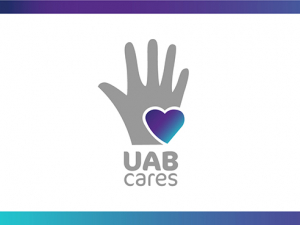

 Be safe, not a statistic: Pedestrian fatalities have risen 46 percent since 2009.
Be safe, not a statistic: Pedestrian fatalities have risen 46 percent since 2009.
